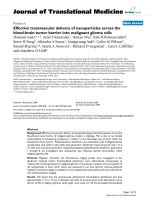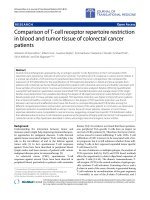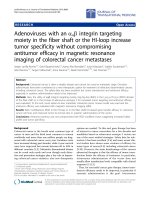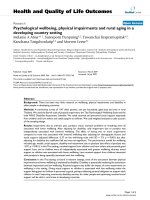báo cáo hóa học:" Single column locking plate fixation is inadequate in two column acetabular fractures. A biomechanical analysis" doc
Bạn đang xem bản rút gọn của tài liệu. Xem và tải ngay bản đầy đủ của tài liệu tại đây (1.42 MB, 6 trang )
Khajavi et al. Journal of Orthopaedic Surgery and Research 2010, 5:30
/>Open Access
RESEARCH ARTICLE
BioMed Central
© 2010 Khajavi et al; licensee BioMed Central Ltd. This is an Open Access article distributed under the terms of the Creative Commons
Attribution License ( which permits unrestricted use, distribution, and reproduction in
any medium, provided the original work is properly cited.
Research article
Single column locking plate fixation is inadequate
in two column acetabular fractures.
A biomechanical analysis
Kiarash Khajavi
1
, Arthur T Lee
1
, Derek P Lindsey
2
, Philipp Leucht*
1
, Michael J Bellino
1
and Nicholas J Giori
2
Abstract
Background: The objective of this study was to determine whether one can achieve stable fixation of a two column
(transverse) acetabular fracture by only fixing a single column with a locking plate and unicortical locking screws. We
hypothesized that a locking plate applied to the anterior column of a transverse acetabular fracture would create a
construct that is more rigid than a non-locking plate, and that this construct would be biomechanically comparable to
two column fixation.
Methods: Using urethane foam models of the pelvis, we simulated transverse acetabular fractures and stabilized them
with 1) an anterior column plate with bicortical screws, 2) an anterior locking plate with unicortical screws, 3) an
anterior plate and posterior column lag screw, and 4) a posterior plate with an anterior column lag screw. These
constructs were mechanically loaded on a servohydraulic material testing machine. Construct stiffness and fracture
displacement were measured.
Result and Discussion: We found that two column fixation is 54% stiffer than a single column fixation with a
conventional plate with bicortical screws. There was no significant difference between fixation with an anterior column
locking plate with unicortical screws and an anterior plate with posterior column lag screw. We detected a non-
significant trend towards more stiffness for the anterior locking plate compared to the anterior non-locking plate.
Conclusion: In conclusion, a locking plate construct of the anterior column provides less stability than a traditional
both column construct with posterior plate and anterior column lag screw. However, the locking construct offers
greater strength than a non-locking, bicortical construct, which in addition often requires extensive contouring and its
application is oftentimes accompanied by the risk of neurovascular damage.
Introduction
Intraarticular acetabular fractures are commonly treated
with open reduction and internal fixation. Transverse
acetabular fractures, as defined by Letournel and Judet
[1], extend intraarticularly across both the anterior and
posterior column of the pelvis, and divide the pelvis into a
superior segment containing the roof and intact ilium
and an inferior segment consisting of a single ischio-
pubic segment. Internal fixation of these fractures often
involves a combination of plates and screws to maintain
perfect reduction. Fixation may involve plating of the
anterior column and posterior column, or plating of one
column in conjunction with lag screw fixation of the
opposite column. In a biomechanical analysis, Shazar et
al. showed that plating of one column in conjunction with
lag screw fixation of the opposite column provided the
stiffest construct compared to plating of a single column
[2].
Locking plates have recently been developed for the
internal fixation of fractures, and are gaining widespread
acceptance. Locking plates have several advantages over
traditional screw/plate constructs. There is improved
angular stability because each screw acts as a small fixed-
angled device. One can thus obtain better fixation in
osteoporotic bone, and there is the opportunity to use
unicortical, rather than bicortical screws [3-5]. Because
fixation does not depend on friction between the plate
* Correspondence:
1
Department of Orthopaedic Surgery, Stanford University School of Medicine,
300 Pasteur Drive, Stanford, CA 94305, USA
Full list of author information is available at the end of the article
Khajavi et al. Journal of Orthopaedic Surgery and Research 2010, 5:30
/>Page 2 of 6
and bone, one can apply plates with less disruption to
periosteal blood supply and potentially improve the bio-
logical environment for fracture healing [3,6-8].
There are no current studies that have investigated the
application of locking plates to acetabular fractures, and
in particular, transverse acetabular fractures. We set out
to compare the biomechanical stability of locking pelvic
reconstruction plates with constructs that have previ-
ously been tested in the literature (i.e. non-locking plates
as well as constructs that provide fixation of both the
anterior and posterior columns). We hypothesize that a
locking plate applied to the anterior column of a trans-
verse acetabular fracture will result in a construct that is
more rigid than a non-locking plate, and that this con-
struct would be biomechanically comparable in stiffness
and stability to two column fixation.
Materials and methods
Forty urethane foam hemi-pelvises (Pacific Research Lab-
oratories, Vashon, Washington), each with a well defined
cortical outer shell and cancellous inner matrix were ran-
domly divided into four groups of ten. Urethane foam
hemi pelvises were chosen to control for the variability in
cadaveric specimens as well as for the large number of
specimens needed based on our power analysis. An iden-
tical transtectal osteotomy using a hand held saw was
performed on each of the specimens (Fig. 1a). The osteot-
omy began at the mid portion of the greater sciatic notch
and traveled across the posterior column, through the
roof of the acetabulum, exiting through the anterior col-
umn at the level of the iliopectineal eminence.
The osteotomy was reduced anatomically and fixed in
one of four ways: 1) a 10 hole 3.5 mm anterior column
reconstruction plate with three bicortical screws on
either side of the osteotomy (ACP), 2) a 10 hole 3.5 mm
anterior column locking reconstruction plate with three
unicortical screws on either side of the osteotomy
(LOCK), 3) a 10 hole 3.5 mm anterior column recon-
struction plate with three bicortical screws on either side
of the osteotomy and a 4.5 mm/120 mm posterior col-
umn lag screw (ACPLS), and finally 4) a 6 hole 3.5 mm
posterior column reconstruction plate with three bicorti-
cal screws on either side of the osteotomy and a 4.5 mm/
120 mm anterior column lag screw (PCPLS) (Fig 1b-e).
Each specimen was stabilized in a customized jig (Fig
2a). A PMMA mold stabilized the superior osteotomy
fragment (i.e. the intact ilium) and was bolted to the test-
ing table for stability. To enforce an anatomic boundary
condition at the pubis, the pubic symphysis rested on a
block of wood that was cut at an angle that matched the
anatomical mid-sagittal plane. Thus, the only constraint
to motion of the inferior portion of the pelvis was that the
pubic symphysis portion of the hemipelvis could not
cross the mid-sagittal plane of the body. It was otherwise
free to translate and rotate in all other directions.
A bipolar hemiarthroplasty was attached to a servohy-
draulic material testing machine (858 Mini Bionix, MTS,
Eden Prairie, MN) in order to load the construct. The
customized jig was oriented to allow femoral head load-
Figure 1 (A) A urethane foam pelvis used in this study is shown
with a line demonstrating the location of the simulated trans-
verse acetabular fracture. (B) A 10 hole 3.5 mm anterior column re-
construction plate with three bicortical screws on either side of the
osteotomy (ACP). (C) A 10 hole 3.5 mm anterior column reconstruction
plate with three bicortical screws on either side of the osteotomy and
a 4.5 mm/120 mm posterior column lag screw (ACPLS). (D) A 10 hole
3.5 mm anterior column locking reconstruction plate with three uni-
cortical screws on either side of the osteotomy (LOCK). (E) A 6 hole 3.5
mm posterior column reconstruction plate with three bicortical screws
on either side of the osteotomy and a 4.5 mm/120 mm anterior col-
umn lag screw (PCPLS).
Figure 2 (A) The testing apparatus consists of a bipolar hemiar-
throplasty attached to a servohydraulic materials testing ma-
chine (858 Mini Bionix, MTS, Eden Prairie, MN). The customized jig
was oriented to allow femoral head loading to be oriented 45 degrees
superomedially (coronal plane) and 25 degrees posteriorly. (B) The
hemiarthroplasty head is in the acetabulum at the top of the figure. To
the left is the ischium and to the right is the ilium. The numbered pins
were used to record motion at the fracture site.
Khajavi et al. Journal of Orthopaedic Surgery and Research 2010, 5:30
/>Page 3 of 6
ing to be oriented 45 degrees superomedially (coronal
plane) and 25 degrees posteriorly (sagittal plane) [1,9,10].
Prior to specimen loading four markers were attached
to each osteotomized urethane foam pelvis to allow mea-
surement of the relative motion across the osteotomy
(Fig. 2b). These markers were placed along the posterior
column of the pelvis adjacent to the osteotomy gap. The
markers were placed 5 mm from the gap on each side of
the fracture line and were placed 2 cm apart. Two oppos-
ing markers (numbers 1 and 2) were in a more anterior
position along the osteotomy line, while the other two
opposing markers (numbers 3 and 4) were in a more pos-
terior position. A photograph was taken with a digital
camera (Coolpix 8700; Nikon) attached to a tripod in the
unloaded state with a ruler in the field of view to allow for
subsequent calibration. Specimens were then loaded at
0.2 mm/sec to 1000N and another photograph was taken.
Lastly, the specimens were loaded up to 2000N while pis-
ton displacement and load were acquired and then a final
photograph was taken. To avoid the effects of the toe
region, stiffness of the construct was calculated between
1000 and 2000 N, where the load-displacement curve was
most linear.
Marker positions from the three images were analyzed
using ImageJ ( />; NIH, Bethesda,
MD). The four markers were used to define how the gap
opened at 2000N relative to 0N for the four plated con-
structs. Displacements at two points along the fracture
line were defined. The anterior displacement was defined
as the movement of pin 1 relative to pin 2, and the poste-
rior displacement was defined as the movement of pin 3
relative to pin 4.
To represent overall motion of the fracture fragments at
the fracture site, the average location of each pin in space
for each fixation scheme was graphed. Visualizing the
displacements in this way allows one to understand how
the fracture displaced under load, either perpendicular to
the fracture line and creating a gap, or parallel to the frac-
ture line and generating shear.
Differences in stiffness of the various plating constructs
were then analyzed using an ANOVA test. Assuming a
stiffness standard deviation of 0.25 N/mm and a differ-
ence desired to detect of 0.5 N/mm, we calculated that 10
specimens per group would give a power of 0.9986. Stan-
dard deviation and mean values were based on a previous
study [10].
Results
Analysis of construct stiffness
In order to test our hypothesis that a locking plate applied
to the anterior column of a transverse acetabular fracture
will result in a construct that is more rigid than a non-
locking plate and that this construct would be biome-
chanically comparable in stiffness to two column fixation,
we loaded the four fixation construct with the above
described protocol. Typical photos of the fracture site at
2000 N loading with the four fixation schemes are shown
in Figure 3a-d. The stiffness of the repaired transverse
acetabular fracture construct as measured by the motion
of the piston of the materials testing machine and the
force applied by the piston is summarized in Figure 4a.
We found that constructs with two column fixation were
statistically stiffer than an anterior column plate alone.
Only the posterior column plate with an anterior lag
screw was statistically stiffer than the anterior locking
plate. There was no statistical difference between the
anterior locking plate and the anterior column plate with
posterior lag screw. A construct of an anterior column
plate with a posterior column lag screw (ACPLS) is 41%
stiffer than the anterior column plate (ACP) alone (p =
0.0365) and 21% stiffer than the anterior column locking
plate (LOCK) (p = 0.2485). A posterior column plate and
an anterior column lag screw (PCPLS) is 53% stiffer than
a single anterior column plate (ACP) (p = 0.0005) and
31% stiffer than an anterior column locking plate (LOCK)
(p = 0.0008). There was no statistical difference between
the single column fixation schemes (anterior column
reconstruction plate with bicortical screws (ACP) and the
anterior column reconstruction locking plate with uni-
cortical screws (LOCK)(p = 0.248)), and there was also no
statistical difference between the two column fixation
schemes (anterior column plate/post column lag screw
(ACPLS) and posterior column plate/anterior column lag
screw (PCPLS)).
Analysis of fracture displacement
Displacements at the fracture site reflect the stiffness of
fixation that was measured by the displacement of the
loading piston (Figure 4b). There was no statistically sig-
nificant difference in fracture displacements between the
single column fixation constructs, and there were no sta-
tistically significant differences in fracture displacements
between the two column fixation constructs. The two col-
umn fixation constructs allowed about half the fracture
displacement as single column fixation constructs. A
graphical representation of the overall fracture movement
(Figure 4c) reveals that most of the displacement mea-
sured for all fixation schemes was in the shear direction.
Discussion
As new methods of biomechanical fixation of transverse
acetabular fractures are introduced, studies are needed to
compare their biomechanical strength with constructs
that are well established. Our study was designed to com-
pare the fixation stiffness of transverse acetabular frac-
tures using anterior column locking plates, conventional
anterior column plates, and plate-lag screw combina-
tions.
Khajavi et al. Journal of Orthopaedic Surgery and Research 2010, 5:30
/>Page 4 of 6
For this study we chose polyurethane foam as an alter-
native test medium for human cancellous bone. These
polyurethane foam pelvi are not intended to replicate the
mechanical properties of human bone, however, they do
provide consistent and uniform material with properties
in the range of human cancellous bone. Polyurethane
models allowed us to test a large number of pelvi that
were required to complete this study with adequate
power. Though the actual values of displacement and
force that we report in this study may not represent the
values that one would find in testing a bony pelvis, we
believe the general findings of our study are applicable to
the clinical situation.
The direction in which we chose to load our specimen
matched the loading direction of previous studies, and
thus allowed for the comparison of data [1,9,10]. This
loading direction, however, represents one of an infinite
number of possible loading directions for the hip. Rising
from a chair, descending stairs, and other common clini-
cal scenarios were not modeled in our study.
Our study revealed that two-column fixation con-
structs are significantly stiffer than a single column fixa-
tion construct with a conventional plate. We were not
able to detect a significant difference between an anterior
column locking plate (LOCK) and an anterior plate with
posterior column lag screw (ACPLS). There was, how-
ever, a trend towards the ACPLS being stiffer than the
LOCK. Only the posterior plate with anterior column lag
screw (PCPLS) was significantly stiffer than the single
column constructs.
In cases where a single column fixation may suffice, an
anterior locking plate offers 16% more stiffness than a
conventional plate. In addition, the locking construct
provides some important advantages. First, locking plates
do not depend on plate-bone contact and friction to
achieve stability. Fracture fixation with a conventional
plate relies on the compressive force provided by the
screw head to the plate and the friction coefficient
between plate and bone [3]. Insufficient compressive
force from the screw head to the plate or insufficient fric-
tion between the plate and the bone will result in com-
promise of stability across the fracture site, and potential
failure of fixation. The complex shape of the pelvis and
the difficulty of the approach make achieving good plate-
Figure 3 Representative photos of displacement at the fracture site with all four fixation schemes at 2000 N of loading are shown. (A) An-
terior column plate; (B) Anterior column plate with posterior column lag screw; (C) Anterior column locking plate; (D) Posterior column plate with an-
terior column lag screw.
Khajavi et al. Journal of Orthopaedic Surgery and Research 2010, 5:30
/>Page 5 of 6
bone contact more difficult than when plating a long
bone fracture. Plate contouring is not an issue when a
locked plate is used as it achieves fixation as a fixed angle
device and does not depend on plate-bone contact. Sec-
ond, since similar fixation can be achieved with the lock-
ing plate using unicortical screws as with a conventional
plate using bicortical screws, one would expect that the
likelihood of iatrogenic neurovascular injury and joint
penetration during pelvic and acetabular surgery would
be reduced with placement of unicortical screws.
In conclusion, two column fixation provides the biome-
chanically stiffest construct for stabilization of transverse
acetabular fractures, a finding that is consistent with pre-
viously published reports. We were not able to detect a
statistical difference between a single anterior locking
plate and an anterior plate with a posterior column lag
screw. However, a posterior plate with anterior column
lag screw was significantly stiffer than an anterior locking
plate. We found a trend towards greater stiffness of the
anterior locking plate compared to the conventional
plate, but statistical significance was not reached.
Conflict of interests
The authors declare that they have no competing inter-
ests.
Figure 4 (A) Mean stiffness (N/mm) and standard deviations for different fixation modalities. (B) Displacements measured for the anterior
(black) and posterior (white) gaps during loading from 0 to 2000 N for four different pelvic fracture fixation modalities. Values with common super-
scripts are significantly different (p < 0.05). (C) A diagram representing average displacement at the fracture site for the four different fixation schemes
is shown. The reference superior edge of the fracture line is represented by the solid vertical black line in the central-upper part of this figure. The
colored lines to the left and below this reference line represent the average location of the opposing inferior fracture edges after load is applied, and
are based on the movement of the pins in the photographs as seen in Figure 3. Motion in the -X direction represents opening of the fracture gap and
-Y represents shear motion at the fracture site. The single column fixation schemes (ACP and LOCK) displaced approximately twice as much as the
two-column fixation schemes (ACPLS and PCPLS).
$&3 /2&. $&3/6 3&3/6
DE
D
F
EF
VWLIQHVV1PP
DQWHULRU
GLVSODFHPHQW
SRVWHULRU
GLVSODFHPHQW
FG
$&3 /2&. $&3/6 3&3/6
DE
DF
EG
$%
&
$&3
$&3/6
/2&.
3&3/6
LQWDFW
gap (cm)
shear (cm)
GLVSODFHPHQWLQFP
Khajavi et al. Journal of Orthopaedic Surgery and Research 2010, 5:30
/>Page 6 of 6
Authors' contributions
KK, ATL and DPL carried out the experiments, PL, MJB and NJG participated in
the study's design and coordination and drafted the manuscript. All authors
read and approved the final manuscript.
Acknowledgements
The authors acknowledge the support of the VA Bone & Joint Rehabilitation
R&D Center (Palo Alto, CA) in accomplishing this project. The authors also
thank Synthes North America for the donation of materials for this study.
Author Details
1
Department of Orthopaedic Surgery, Stanford University School of Medicine,
300 Pasteur Drive, Stanford, CA 94305, USA and
2
Bone and Joint Center of
Excellence, VA Palo Alto Healthcare System, 3801 Miranda Ave., Palo Alto, CA
94304, USA
References
1. Letournel E: Fractures of the acetabulum. 2nd edition. New York:
Springer-Verlag; 1993.
2. Shazar N, Brumback RJ, Novak VP, Belkoff SM: Biomechanical evaluation
of transverse acetabular fracture fixation. Clin Orthop Relat Res
1998:215-222.
3. Egol KA, Kubiak EN, Fulkerson E, Kummer FJ, Koval KJ: Biomechanics of
locked plates and screws. J Orthop Trauma 2004, 18(8):488-493.
4. Wong MK, Leung F, Chow SP: Treatment of distal femoral fractures in
the elderly using a less-invasive plating technique. Int Orthop 2005,
29(2):117-120.
5. Kregor PJ, Stannard JA, Zlowodzki M, Cole PA: Treatment of distal femur
fractures using the less invasive stabilization system: surgical
experience and early clinical results in 103 fractures. J Orthop Trauma
2004, 18(8):509-520.
6. Farouk O, Krettek C, Miclau T, Schandelmaier P, Tscherne H: Effects of
percutaneous and conventional plating techniques on the blood
supply to the femur. Archives of Orthopaedic and Trauma Surgery 1998,
117(8):438-441.
7. Farouk O, Krettek C, Miclau T, Schandelmaier P, Guy P, Tscherne H:
Minimally invasive plate osteosynthesis: does percutaneous plating
disrupt femoral blood supply less than the traditional technique? J
Orthop Trauma 1999, 13(6):401-406.
8. Farouk O, Krettek C, Miclau T, Schandelmaier P, Guy P, Tscherne H:
Minimally invasive plate osteosynthesis and vascularity: preliminary
results of a cadaver injection study. Injury 1997, 28(Suppl 1):A7-12.
9. Bergmann G, Graichen F, Rohlmann A: Hip joint loading during walking
and running, measured in two patients. J Biomech 1993, 26(8):969-990.
10. Chang JK, Gill SS, Zura RD, Krause WR, Wang GJ: Comparative strength of
three methods of fixation of transverse acetabular fractures. Clin
Orthop Relat Res 2001:433-441.
doi: 10.1186/1749-799X-5-30
Cite this article as: Khajavi et al., Single column locking plate fixation is inad-
equate in two column acetabular fractures. A biomechanical analysis Journal
of Orthopaedic Surgery and Research 2010, 5:30
Received: 27 December 2009 Accepted: 9 May 2010
Published: 9 May 2010
This article is available from : http://www.j osr-online.com/ content/5/1/30© 2010 Khajavi et al; licensee BioMed Central Ltd. This is an Open Access article distributed under the terms of the Creative Commons Attribution License ( ), which permits unrestricted use, distribution, and reproduction in any medium, provided the original work is properly cited.Journal of Orthopaedic Surgery and Research 2010, 5:30









